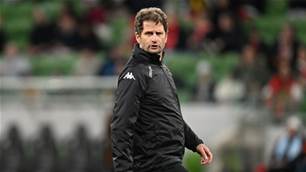While 2020 may yet prove a dismal year for women's football, 2021 will be unforgettable.
As well as regrouping after the worst of COVID19, women's football in Australia will also celebrate its 100th birthday.
On 24 September 1921, the first public women's football match in Australia was played at the Gabba between the North Brisbane Reds and the South Brisbane Blues.
A crowd of 10,000 gathered on a warm spring afternoon to see the Reds win 2-0 in an exciting Brisbane 'derby'.
“It’s an amazing story,” says former Matilda Deb Nichols. “I had no idea how much history we had until I read ‘Never Say Die’.”
Sadly in 1922 it was deemed 'inappropriate' for girls to play football. It took another 56 years for the Australian Women's Soccer Association (AWSA) to be formed. A year later the first official Australian women's team played their first proper international against New Zealand at Seymour Shaw Park in Miranda.
A small crowd turned up to see a thrilling 2-2 draw. Julie Dolan was cap number one and captained Australia that day. Dolan and her teammates famously dropped fliers in mailboxes around the Sutherland Shire to try and attract fans to the historical game.
Fast forward 41 years and our Matildas are the most loved sporting team in Australia. Sam Kerr is a genuine household name.
A number of our players are playing in the best leagues around the world and earning decent money doing so. We have a fledgling W-League which is beamed live into lounge rooms across the country.
“You don't realise at the time but to have come from an era of training on cow paddocks and car parks to where we are today is very humbling,” says Nichols.
“Those who forged our pathway and opportunity did so much to start this in harder times than I even experienced.”
There are now 141,000 registered footballers, 7,700 coaches, 1,200 referees and over 10,000 volunteers across the country who are female.
Nichols, who was part of the ‘unofficial World Cup’ held in 1988 in China, believes we should use the centenary of women’s football to lobby governments to provide additional funding for female footballers.
“We have a shortage across the board for both males and females,” believes Nichols.
“The lack of facilities means we cant give the opportunity to all to be able to play and some potentials will miss out. Quality surfaces are critical for technical development - these are seriously lacking at grassroots levels.
“We also need to reduce the cost to play regardless of level to capture those who have potential.”
Nichols, a junior coach at NPLW club Southern United, would also like FFA to address what is considered the next frontier of women’s football.
“Development of female coaches is vital. It has been talked about over the last few years but continues to challenge federations
“We need to start at the grassroots to increase the pool and it needs to be easier to do a course. Not to make a course easy, but make it easier for females with family and work commitments to participate.
“This can then build a network of females who can be identified to have the opportunity to further develop to the elite level.”
Another former Matilda in Shelley Youman, who played for Australia after starting a family, echoed Nichols’ sentiments but goes further, encouraging governing bodies to hire the right people who are in charge of making decisions.
“The key is to invest in the people who genuinely love women's football and convince the people who sit on the fence how good this is," Youman said.
“There will always be a majority who will criticize so don't waste your energy. We have a great product that needs to be marketed well.
“I have seen some great female footballers in my time so the talent has always been there its how we build a business around it.”
Youman recalls how female footballers were stereotyped in the past, but was quick to point out how perceptions have changed, a testament to the evolution of the game and society over the past 100 years.
"I hated the days that people thought you were gay or unfeminine if you played football.
“I tried extra hard to ensure I looked feminine in my younger days but I just loved playing sport. I'm glad that girls can be themselves now and the attitude has changed.
“Parents are encouraging girls to play all football codes as well as cricket so minds are changing.”
Western Sydney Wanderers midfielder and another former Matilda, Ella Mastrantonio, who many suggest is in line for a national recall after a 12-year hiatus, appreciated the significance of the milestone and admitted she was proud to be part of such history.
“Pretty amazing it’s been 100 years since the first women’s football game,” she said.
“Makes you proud to know how long ago we started to where we are as a nation now in regards to female participation and equality within the game and women’s sport in general.”
Mastrantonio emphasised the importance of building a strong culture for women’s football, and identified fans as the key to this happening.
“Key to progression is our football culture. It’s fantastic to see where we are now, with interest and participation the highest for any sport in the country, but to be able to build a football culture where we live and breathe it, where fans flock to the stadiums to see all levels of the game is something I, and I’m sure a lot of others, dream of.”
Next year’s celebrations will coincide with the recently moved Tokyo Olympics and plans for the 2023 Women’s World Cup, which could potentially be in Australia.
It could indeed be a special time for Australian women’s football.
Related Articles

'Timing not right': Montemurro's verdict on Matildas vacancy

Matildas: 'Fourth at the Olympics is honestly the worst place you could come'
.jpg&h=172&w=306&c=1&s=1)












